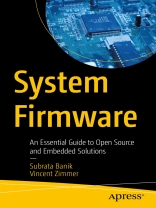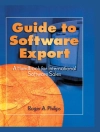Find the right bootloader solution or combination of firmware required to boot a platform considering its security, product features, and optimized boot solutions. This book covers system boot firmware, focusing on real-world firmware migration from closed source to open source adaptation.
The book provides an architectural overview of popular boot firmware. This includes both closed sourced and/or open source in nature, such as Unified Extensible Firmware Interface (UEFI), coreboot, and Slim Bootloader and their applicable market segments based on product development and deployment requirements.
Traditional system firmware is often complex and closed sourced whereas modern firmware is still a kind of hybrid between closed and open source. But what might a future firmware model look like? The most simplistic boot firmware solution uses open source firmware development. This bookhelps you decide how to choose the right boot firmware for your products and developyour own boot firmware using open source. Coverage includes:
- Why open source firmware is used over closed source
- The pros and cons of closed and open source firmware
- A hybrid work model: for faster bring-up activity using closed source, binary integrated with open source firmware
What You Will Learn
- Understand the architecture of standard and popular boot firmware
- Pick the correct bootloader for your required target hardware
- Design a hybrid workflow model for the latest chipset platform
- Understand popular payload architectures and offerings for embedded systems
- Select the right payload for your bootloader solution to boot to the operating system
- Optimize the system firmware boot time based on your target hardware requirement
- Know the product development cycle using open source firmware development
Who This Book Is For
Embedded firmware and software engineers migrating the product development from closed source firmware to open source firmware for product adaptation needs as well as engineers working for open source firmware development. A secondary audience includes engineers working on various bootloaders such as open source firmware, UEFI, and Slim Bootloader development, as well as undergraduate and graduate students working on developing firmware skill sets.
Spis treści
Chapter 1: Introduction.- Chapter 2: Knowing Your Hardware.- Chapter 3: Understanding BIOS and Minimalistic Design.- Chapter 4: System Firmware Architecture.- Chapter 5: Hybrid Firmware Architecture.- Chapter 6: Payload.- Chapter 7: Case Studies.- Appendix A: Postcodes.- Appendix B: Data Types.
O autorze
Subrata Banik is a Firmware Engineer with more than a decade being spent in the computer industry and acquired experiences in system firmware design, development and debugging across various firmware architectures like UEFI, coreboot, Slim bootloader etc. for x86 and ARM platforms. Subrata has profound experience on platform enablement that leads into working for all the leading PC-makers’ products. Subrata is an active member of open-source firmware (OSF) development across different projects like coreboot, oreboot, flashrom, EDKII etc., where he is one of the leading contributors in the open firmware (coreboot) development. Subrata has received multiple US Patents and is very passionate about learning new technology and sharing knowledge among enthusiast engineers. Subrata has presented his technical talks at industry events such as Open Source Firmware conference, Institute for Security and Technology, Intel Developer Forum etc.
When not writing or working, he can be found enjoying watching sports (especially football) or spending time with his daughter. A fun fact about Subrata is, he is a strong believer of Time travel existence.
Vincent Zimmer has been working on embedded firmware for the last 30 years. Vincent has contributed to or created firmware spanning various firmware initiatives, including the Extensible Firmware Interface, where Vincent presently leads the Security subteam in the UEFI Forum. Vincent has also co-authored various papers and books, along with being a named co-inventor on over 450 US patents.












